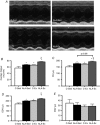α-Linolenic acid and exercise training independently, and additively, decrease blood pressure and prevent diastolic dysfunction in obese Zucker rats
- PMID: 28345766
- PMCID: PMC5491862
- DOI: 10.1113/JP274036
α-Linolenic acid and exercise training independently, and additively, decrease blood pressure and prevent diastolic dysfunction in obese Zucker rats
Abstract
Key points: α-linolenic acid (ALA) and exercise training both attenuate hyperlipidaemia-related cardiovascular derangements, however, there is a paucity of information pertaining to their mechanisms of action when combined. We investigated both the independent and combined effects of exercise training and ALA consumption in obese Zucker rats, aiming to determine the potential for additive improvements in cardiovascular function. ALA and exercise training independently improved cardiac output, end-diastolic volume, left ventricular fibrosis and mean blood pressure following a 4 week intervention. Combining ALA and endurance exercise yielded greater improvements in these parameters, independent of changes in markers of oxidative stress or endogenous anti-oxidants. We postulate that divergent mechanisms of action may explain these changes: ALA increases peripheral vasodilation, and exercise training stimulates angiogenesis.
Abstract: Although α-linolenic acid (ALA) and endurance exercise training independently attenuate hyperlipidaemia-related cardiovascular derangements, there is a paucity of information pertaining to their mechanisms of action and efficacy when combined as a preventative therapeutic approach. Therefore, we used obese Zucker rats to investigate the independent and combined effects of these interventions on cardiovascular disease. Specifically, animals were randomly assigned to one of the following groups: control diet-sedentary, ALA supplemented-sedentary, control diet-exercise trained or ALA supplemented-exercise trained. Following a 4 week intervention, although the independent and combined effects of ALA and exercise reduced (P < 0.05) the serum free/esterified cholesterol ratio, only the ALA supplemented-exercise trained animals displayed a reduction in the content of both serum free and esterified cholesterol. Moreover, although ALA and endurance training individually increased cardiac output, stroke volume and end-diastolic volume, as well as reduced left ventricle fibrosis, mean blood pressure and total peripheral resistance, these responses were all greater following the combined intervention (ALA supplemented-exercise trained). These effects occurred independent of changes in oxidative phosphorylation proteins, markers of oxidative stress or endogenous anti-oxidant capacity. We propose that the beneficial effects of a combined intervention occur as a result of divergent mechanisms of action elicited by ALA and endurance exercise because only exercise training increased the capillary content in the left ventricle and skeletal muscle, and tended to decrease protein carbonylation in the left ventricle (P = 0.06). Taken together, our data indicate that combining ALA and endurance exercise provides additional improvements in cardiovascular disease risk reduction compared to singular interventions in the obese Zucker rat.
Keywords: PUFA; angiogenesis; diabetic cardiomyopathy; exercise physiology; heart.
© 2017 The Authors. The Journal of Physiology © 2017 The Physiological Society.
Figures








Similar articles
-
α-Linolenic acid supplementation and exercise training reveal independent and additive responses on hepatic lipid accumulation in obese rats.Am J Physiol Endocrinol Metab. 2017 Jun 1;312(6):E461-E470. doi: 10.1152/ajpendo.00438.2016. Epub 2017 Mar 7. Am J Physiol Endocrinol Metab. 2017. PMID: 28270444 Free PMC article.
-
α-linolenic acid supplementation prevents exercise-induced improvements in white adipose tissue mitochondrial bioenergetics and whole-body glucose homeostasis in obese Zucker rats.Diabetologia. 2018 Feb;61(2):433-444. doi: 10.1007/s00125-017-4456-3. Epub 2017 Oct 1. Diabetologia. 2018. PMID: 28965129
-
Both linoleic and α-linolenic acid prevent insulin resistance but have divergent impacts on skeletal muscle mitochondrial bioenergetics in obese Zucker rats.Am J Physiol Endocrinol Metab. 2014 Jul 1;307(1):E102-14. doi: 10.1152/ajpendo.00032.2014. Epub 2014 May 20. Am J Physiol Endocrinol Metab. 2014. PMID: 24844257
-
Recommendations for resistance exercise in cardiac rehabilitation. Recommendations of the German Federation for Cardiovascular Prevention and Rehabilitation.Eur J Cardiovasc Prev Rehabil. 2004 Aug;11(4):352-61. doi: 10.1097/01.hjr.0000137692.36013.27. Eur J Cardiovasc Prev Rehabil. 2004. PMID: 15292771 Review.
-
Alpha-Linolenic Acid and Cardiovascular Events: A Narrative Review.Int J Mol Sci. 2023 Sep 20;24(18):14319. doi: 10.3390/ijms241814319. Int J Mol Sci. 2023. PMID: 37762621 Free PMC article. Review.
Cited by
-
SIRT6‑specific inhibitor OSS‑128167 exacerbates diabetic cardiomyopathy by aggravating inflammation and oxidative stress.Mol Med Rep. 2021 May;23(5):367. doi: 10.3892/mmr.2021.12006. Epub 2021 Mar 24. Mol Med Rep. 2021. PMID: 33760202 Free PMC article.
-
The Physiological Effect of n-3 Polyunsaturated Fatty Acids (n-3 PUFAs) Intake and Exercise on Hemorheology, Microvascular Function, and Physical Performance in Health and Cardiovascular Diseases; Is There an Interaction of Exercise and Dietary n-3 PUFA Intake?Front Physiol. 2019 Aug 30;10:1129. doi: 10.3389/fphys.2019.01129. eCollection 2019. Front Physiol. 2019. PMID: 31543828 Free PMC article. Review.
-
α-Linolenic Acid and Risk of Heart Failure: A Meta-Analysis.Front Cardiovasc Med. 2022 Jan 4;8:788452. doi: 10.3389/fcvm.2021.788452. eCollection 2021. Front Cardiovasc Med. 2022. PMID: 35059448 Free PMC article.
-
Beneficial Effects of Polyphenol-Rich Food Oils in Cardiovascular Health and Disease.Rev Cardiovasc Med. 2023 Jul 3;24(7):190. doi: 10.31083/j.rcm2407190. eCollection 2023 Jul. Rev Cardiovasc Med. 2023. PMID: 39077008 Free PMC article. Review.
-
Diabetic cardiomyopathy in rats was attenuated by endurance exercise through the inhibition of inflammation and apoptosis.Heliyon. 2023 Dec 6;10(1):e23427. doi: 10.1016/j.heliyon.2023.e23427. eCollection 2024 Jan 15. Heliyon. 2023. PMID: 38163155 Free PMC article.
References
-
- Alonso‐Galicia M, Brands MW, Zappe DH & Hall J E (1996). Hypertension in obese Zucker rats: role of angiotensin II and adrenergic activity. Hypertension 28, 1047–1054. - PubMed
-
- Anderson EJ, Thayne KA, Harris M, Shaikh SR, Darden TM, Lark DS, Williams JM, Chitwood WR, Kypson AP & Rodriguez E (2014). Do fish oil omega‐3 fatty acids enhance antioxidant capacity and mitochondrial fatty acid oxidation in human atrial myocardium via PPARγ activation? Antioxid Redox Signal 21, 1156–1163. - PMC - PubMed
-
- Aneja A, Tang WHW, Bansilal S, Garcia MJ & Farkouh ME (2008). Diabetic cardiomyopathy: insights into pathogenesis, diagnostic challenges, and therapeutic options. Am J Med 121, 748–757. - PubMed
-
- Aroor AR, Sowers JR, Bender SB, Nistala R, Garro M, Mugerfeld I, Hayden MR, Johnson MS, Salam M, Whaley‐Connell A & DeMarco VG (2013). Dipeptidylpeptidase inhibition is associated with improvement in blood pressure and diastolic function in insulin‐resistant male Zucker obese rats. Endocrinology, 154, 2501–2513. - PMC - PubMed
Publication types
MeSH terms
Substances
LinkOut - more resources
Full Text Sources
Other Literature Sources
Medical

